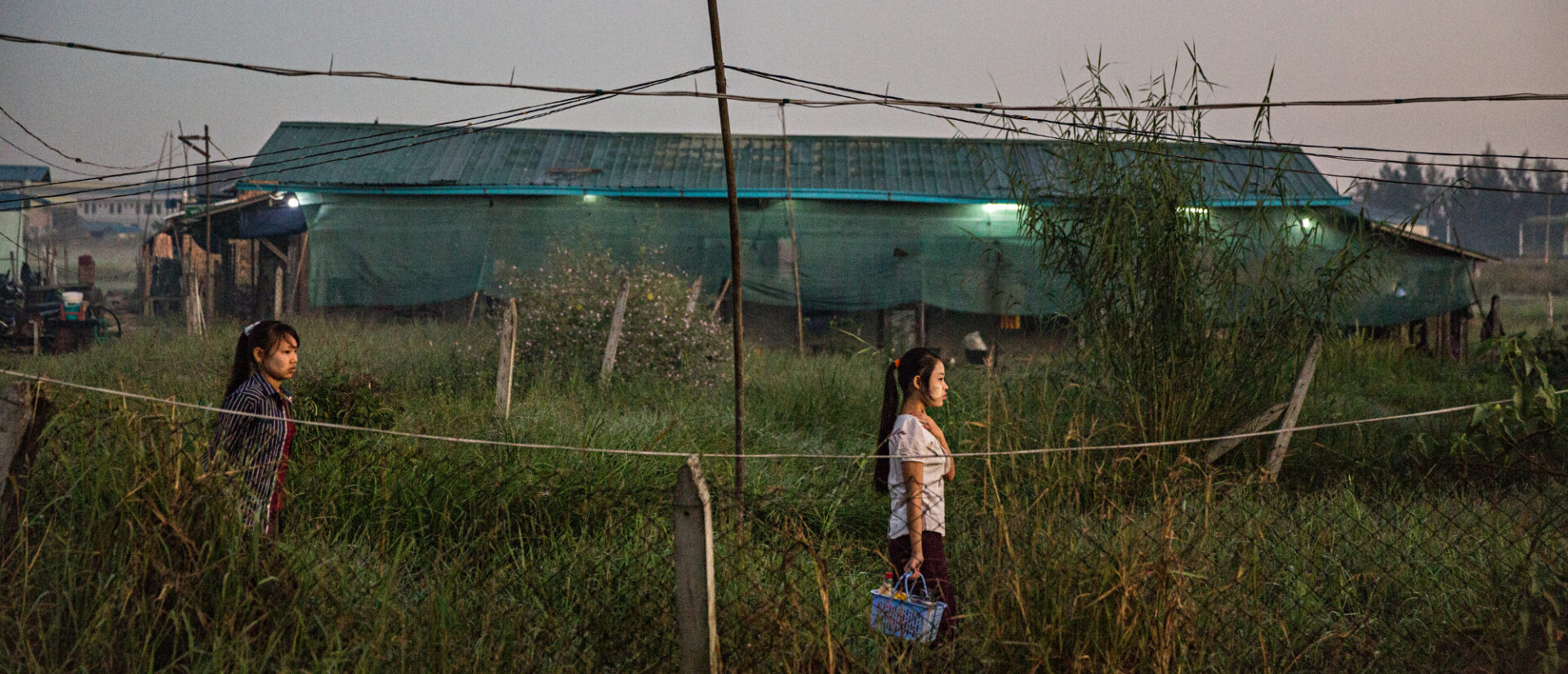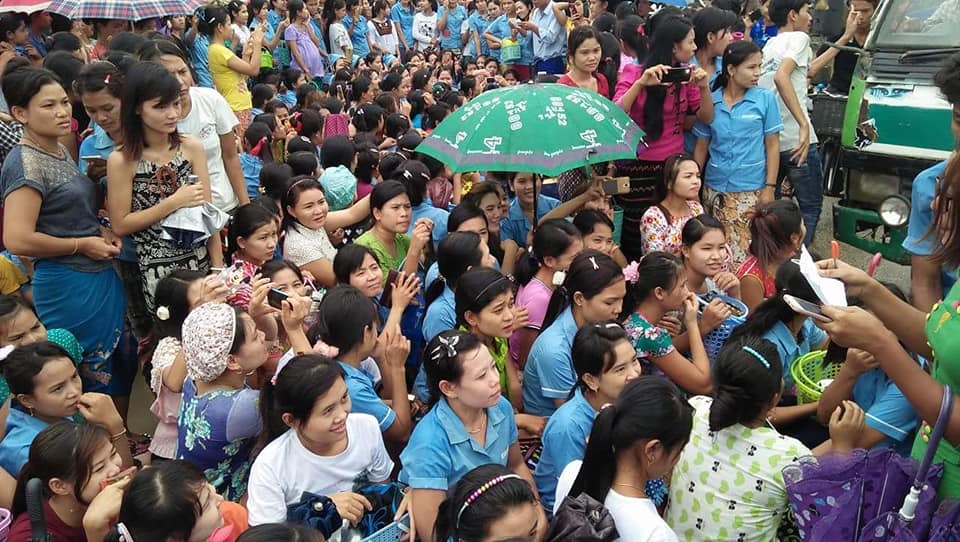
Higher minimum wage in Myanmar
Bad news for workers?


This year the legal minimum wage in Myanmar was raised. In this article the actual effects and feared negative impacts of the new minimum wage are described. SOMO is calling on garment factories in Myanmar, and the international brands that source from them, to get their act together to help prevent and/or address these adverse effects as a matter of urgency.
In May of this year, the legal minimum wage in Myanmar was raised from 3,600 kyat (US$2,30 a day to 4,800 kyat (US$3.00). This sounds like a progressive move that is entirely in the interest of workers. However, the reality shows unintentional consequences that are not benefitting workers at all.
Workers protest over wages
On Tuesday, 10 July 2018, workers from the Young Clothing Ltd. garment factory took to the streets in Myanmar’s largest city Yangon to protest against the increase of hourly production targets coupled with a cutback of the production bonus. The company’s management justified the measures taken by referring to the recently revised minimum wage. Young Clothing (opens in new window) is a British-owned factory that says it ison a journey to create the best factory in Myanmar and has produced goods for well-known brands like Topshop and Muji (Muji confirmed to SOMO that they sourced from Young Clothing until 2017). Young Clothing is a representative example of approximately 600 export-oriented garment factories that currently operate in Myanmar.
On Monday, 16 July 2018, another strike broke out at Myan Mode Co. Ltd(opens in new window) , a garment factory in Hlaingtharyar(a township in Yangon); dozens of workers also protested against increases in production targets in response to increased minimum wage levels. Myan Mode figures on the supplier list(opens in new window) of C&A. Meanwhile, in an address to the workers, the management of Ewha Knit Co. Ltd(opens in new window) announced plans to dismiss one quarter of the current workforce. The reason given by the management for this mass dismissal was the new minimum wage rate. Ewha is one among many Korean-owned garment factories operating in Myanmar that produce for the Korean and international markets.

Higher wages mean higher production targets and longer hours
These examples illustrate thatthe newly increased minimum wage level may not actually be benefiting workers, according to SOMO and a labour rights organisation in Myanmar. Due to higher production targets, workers will have to work harder or even longer (unpaid) hours. Taking into account inflation rates, increasing costs of living and cut production bonuses, workers may not earn a penny more than before the 2018 minimum wage was introduced.
Minimum wage developments over recent years
In 2013, the Minimum Wage Law was adopted, providing a legal framework for determining and implementing a minimum wage. In June 2015, after about two years of tripartite negotiations involving the Ministry of Labour as well as representatives of employers and employees, Myanmar’s first-ever minimum wage level was effectively established at 3,600 kyat a day.From the outset, the amount was highly disputed. Employers said that the minimum wage was unsustainable for business – claiming they would not be able to pay workers more than 2,500 kyat per day.
In particular, Myanmar-owned factories declared they were going to be forced out of business. At least 90 Chinese and South Korean garment manufacturers also threatened to close down their factories(opens in new window) .There is no evidence proving that the industry’s fears have materialised. On the contrary, the export-oriented garment sector has boomed,with the number of factories producing for foreign brands and exported volumes steeply increasing. To take just one example, H&M currently lists 58 suppliers (opens in new window) in Myanmar, compared to 38 suppliers in early 2017.
Race to the bottom – wages in Myanmar lowest in the region
Labour unions stressed that a basic daily wage of 3,600 kyat was not enough to allow workers to make a decent living. Different sources agree that the 2015 minimum wage was indeed set at a low level. A baseline survey (opens in new window) of Yangon’s garment sector workforce, commissioned by the C&A Foundation, described the 2015 minimum wage as “relatively low” compared to wages in other regional garment hubs. For example, Vietnam had become “increasingly expensive”. A comparison (opens in new window) of minimum wages in selected Asian countries showed that Myanmar’s 3,600 kyat rate amounted to a mere $80.28 per month, significantly less than monthly wage rates of $110.34 in Laos, $140 in Cambodia and $147.47 in Vietnam.
SOMO research highlighted this problem in 2017
In The Myanmar Dilemma, a report published in 2017, SOMO described a series of precarious labour issues and actual violations of labour rights in the export-oriented garment industry of Myanmar, based on in-depth interviews with more than 400 workers from 12 garment factories. The most pressing issue was the payment of very low wages, preventing workers from making a decent living and forcing many workers into debt. SOMO even found that a considerable number of workers did not even earn the then legal minimum wage, as factories were deftly avoiding paying the minimum wage by abusing the apprenticeship and probation provisions of the minimum wage law. Other exploitative practices described by SOMO included the downgrading of workers (employing them as ‘helpers’ while they would actually work as sewers); hiring daily labourers; increasing production targets; dismissing existing workers and hiring new workers so that they could be paid the apprentice or probation rate. Further findings discussed in the report include: unlawful wage deductions (for sick leave, for instance); very long working days; unpaid and forced overtime; child labour; and unhealthy and unsafe working conditions.
Employers resist higher wages
The Minimum Wage Law stipulates a new minimum wage should be negotiated every two years. The 2018 daily minimum wage of 4,800 kyat, which officially began to apply for all factories with more than 10 employees on 14 May 2018, has been negotiated intensely over a period of months between the government, employer and worker representatives. When the National Committee for the Minimum Wage first proposed the new daily minimum wage rate on 2 January 2018, both workers and businesses rejected the proposal. On the one hand, employers warned that a 4,800 kyat daily basic wage would force small- and medium-sized industries to close, and called for 4,200 kyat as the maximum. On the other hand, workers and labour unions argued that 4,800 kyat would not be enough to sustain families amid steadily rising prices for basic commodities. Labour unions called for a daily minimum wage rate of at least 5,600 kyat. In the end, the rate of 4,800 kyat was grudgingly accepted as a compromise.
Smaller garment factories lagging behind
Through a series of interviews with workers in July, a labour rights organisation in Myanmar found that bigger garment factories had indeed started implementing the new minimum wage, but smaller garment factories were still lagging behind. According to this labour rights organisation, four collective cases and seven individual wage-related complaint cases had been submitted to the Labour Department in the first two months after the law came into effect.
Through research published in 2017, SOMO learned that Myanmar garment workers often do not have the information and means needed to file a complaint. Workers also lack confidence that the labour arbitration system will work in their favour. Researchers suspect that the wage-related complaints that have been filed may very well form just the tip of the iceberg of general worker discontent about pay. In addition, the a labour rights organisation points out that the Myanmar government does not actively monitor the implementation of the minimum wage, leaving workers open to exploitation.
It is too early to predict how the situation will develop, but concerns over wage issues seem to be justified. Abuses of internship and probation wages, as were commonplace under the previous minimum wage, can only be reported in a couple of months. However, already factories are raising production targets, while lowering production bonuses, as already mentioned above. The labour rights organisation is observing bonus reductions of 30,000 kyat (US$ 19) on a monthly basis, based on ongoing contacts and conversations with workers.
The labour rights organisation in Myanmar is also warning against wide-scale increases of hostel rent rates and food prices. Many garment workers live in hostels, as they come from the impoverished countryside into Yangon to find work. Hostel owners have already seized the minimum wage increase to implement a rent increase. Increases in average monthly hostel rents from 10,000-20,000 kyat (US$ 6,30 – 12,60) to new highs of 50,000-60,000 kyat (US$ 31,50 – 37,80) have been reported which make it even harder for workers to to make ends meet on their meagre wages.
Actual and feared negative effects: a summary
- Abuses of internship wages
- Abuses of probation wages
- Raised production targets
- Lowering of production bonuses
- Longer working hours
- Overtime hours not properly calculated
- Non-payment of overtime rates
- Increase in hostel rent rates
- Increase in food prices
Need to protect workers – what brands should do
Garment brands and retailers that source products from Myanmar must take into account the revised minimum wage rate in their cost calculations, enabling their suppliers to pay workers at least the new legal minimum wage. However, it is unclear at this point whether they are effectively doing this. This type of information is not really shared by buying companies. In 2015, several brands from the global North publically supported the increase in Myanmar’s minimum wage. The Ethical Trading Initiative (ETI) sent a letter(opens in new window) to the Myanmar government on behalf of ETI member companies that were sourcing from Myanmar (at that time). Fair Labor Association (FLA) also wrote a letter(opens in new window) to the Myanmar Ministry of labour on behalf of a number of its member companies including those sourcing from Myanmar, those considering investing in Myanmar, and other concerned companies.
More importantly, buying companies should start implementing pricing policies that enable suppliers to pay workers a living wage without further delay. Using the Clean Clothes Campaign (opens in new window) definition, a living wage is a wage that should be earned in a standard working week (no more than 48 hours) and allow the garment worker to buy food for themselves and their family, pay the rent, pay for healthcare, clothing, transportation and education and have a small amount of savings for unexpected outlays.
The way forward – a regional approach
In addition to corporate action, in SOMO’s view, a systemic and sustainable way to address wage issues is to call for a regional floor wage, as that would effectively stop the garment industry’s wage race to the bottom. The Asia Floor Wage Campaign(opens in new window) , for instance, proposes the implementation of the regional Asia Floor Wage. This wage is of course different in each country’s national currency, but has the power to buy the same set of goods and services in all countries.
To this end, the Myanmar government should collaborate as a matter of urgency with garment-producing countries across the region – in particular Thailand, Bangladesh and Cambodia, and within the Association of Southeast Asian Nations(ASEAN) community – to make sure workers earn a living wage.


Related news
-
Linking labour issues in China to global brands Published on:Posted in category:Publication

-
Chain of consequences Published on:
 Joshua RosenzweigPosted in category:Publication
Joshua RosenzweigPosted in category:Publication Joshua Rosenzweig
Joshua Rosenzweig
-



